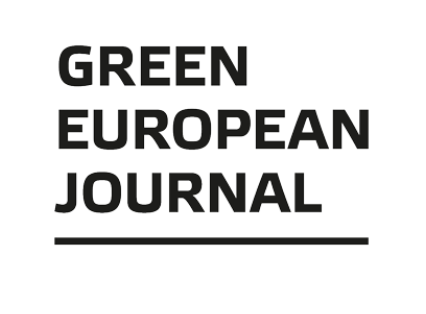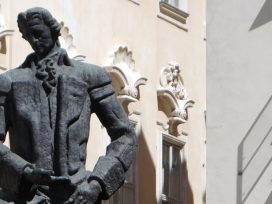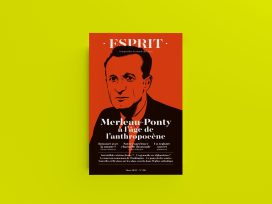Peace to the plates! War on the animals!
Humanism has elevated humanity above its natural condition, but our relationship to animals remains in a state of war. The legally sanctioned slaughtering machine now operates globally, with the poultry industry in particular wielding huge market power.
My grandmother loathed chicken. During the Second World War she was forced to kill and pluck hens. The smell stuck in her nose and she never got it out. Like other Swiss farmers of her generation, in the 1970s and 1980s she bought up battery hens to free them from their caged existence. The exhausted birds, their pink flesh bulging between their dishevelled white feathers, learnt to scratch for food with their knotted claws.
I knew nothing about their past. I thought they were utterly hideous and looked forward to eggs and chicken pieces. But there was something about my grandmother and those hens. I offered suggestions for protecting them against attack from goshawks while we watched westerns on TV. It was astonishingly long before I realised that the creatures needed protection not from the ominous goshawk but from us.
117 years of futility: Aim for the heart and hit the stomach
Like so many things that define our everyday life, factory farming is an American invention. Upton Sinclair’s 1906 novel The Jungle depicts conditions in the Union Stock Yards slaughterhouse in Chicago, the massacre of animals, the dehumanizing work of Eastern European migrants: ‘It was all so very business-like … this slaughtering machine ran on … like some horrible crime committed in a dungeon.’
Sinclair’s descriptions caused a public outcry, but not in the way he wanted. He was a socialist and a vegetarian, a frequent combination in the English-speaking world. After all, social progress cannot be for humans only; it must include animals as well. Hygiene regulations were imposed but nothing changed for the workers or animals. The public, as Sinclair observed bitterly, were only afraid of tubercular beef. ‘I aimed at the public’s heart, and by accident I hit it in the stomach.’
He was optimistic enough to believe that the public actually had a heart. His aim was true but, as the next 117 years would show, there was nothing there but a giant belly.
In the autumn of 2020, the dire working conditions of eastern European abattoir labourers were brought to the public’s attention by a mass outbreak of Covid-19 at a slaughterhouse belonging to the German meat processing company Tönnies. Every year in Germany, around 40 million pigs are lowered on gondolas into chambers filled with carbon dioxide, where they lose consciousness. It takes between 15 and 30 seconds until they pass out. During this time the pigs experience corrosive irritation, loss of breath and panic.
According to German law, ‘No one may cause an animal pain, suffering, or harm without reasonable grounds’. Forty million pigs a year fit into those ‘reasonable grounds’. The carbon-dioxide chamber is efficient and profitable, which justifies between 170,000 and 330,000 hours of pain, distress annually. Working conditions for employees were marginally reformed after the Tönnies scandal; the company redirected its business towards China; and pigs are still being lowered on reasonable grounds.
180 million tonnes of chicken meat: Happy Meals from animal hell
Today the ‘business-like slaughtering machine’ operates globally. The only difference is that the market is dominated not by beef or pork, but the chicken-lives industry. (Did you misread that as ‘chicken liver’?) Over 70% of growth in the global meat industry has been driven by broilers. After the market leaders China, Brazil and the USA, the biggest producers are the European Union, India, Thailand, Mexico, Russia and Turkey.
The imperial behaviour of the poultry industry resembles that of an authoritarian state. The five largest poultry companies together account for 45% of the global market; last year, they killed around 9 billion broilers between them. The world will produce between 130 and 180 million tonnes of chicken meat in the next few years.
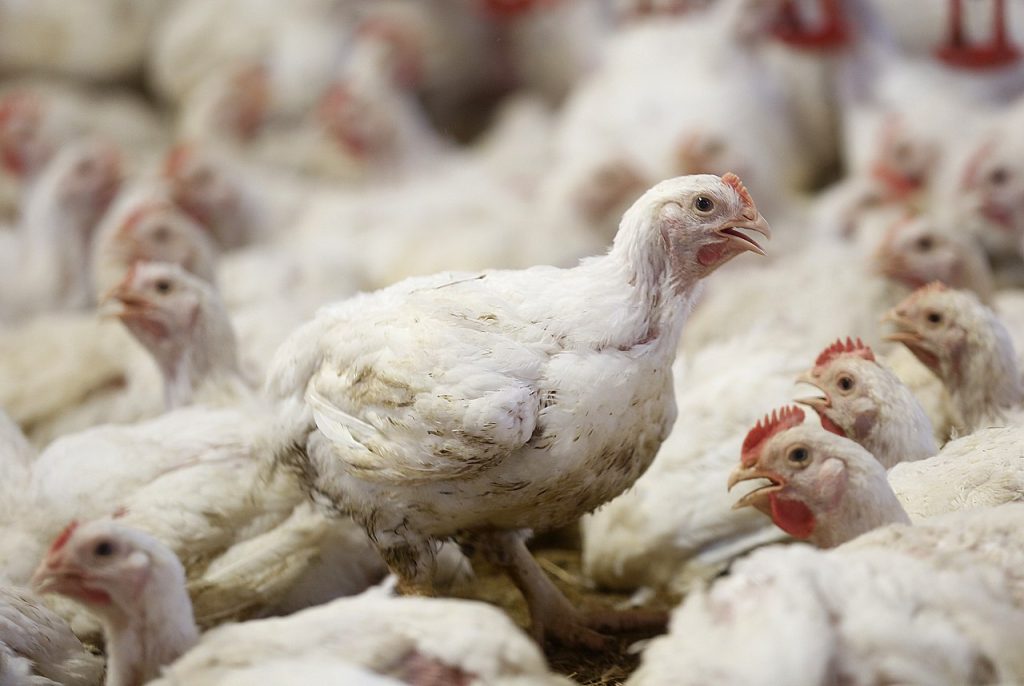
Broiler chickens in Poland, 2017. Image: Otwarte Klatki / Source: Wikimedia Commons
Chicken is booming thanks to its use in fast-food chains, its promotion as a healthy, light, and protein-rich alternative to red meat, the ease and variety of chicken recipes, and an increase in disposable income in some emerging economies. States subsidize the industry with public funds. Enormous numbers of chickens can be kept in small spaces, they grow quickly, and it is nearly impossible to keep track of individual injuries, mutilations or illnesses. Responsibility for waste products and the risk of epidemics are borne by the general public.
Rearing, transport and slaughter are excruciating for chickens. Before slaughter they are crammed into containers. On arrival at the slaughterhouse, they are taken out, flipped over, hung upside down, and tied up. Their heads are dragged through electric water-baths to stun them before they finally they have their throats cut. The electric stunning can cause injury, pain and fear, as can the prior handling, being put upside-down and suspension. The chickens receive electric shocks before their heads even reach the bath, and the shocks in the bath may be too weak or too short to stun them. These animals then have their throats cut while conscious.
Chicken nuggets are, as one fast-food chain advertises, ‘the ideal snack to take with you wherever you go, whenever you’re feeling peckish,’ little bites ‘to enjoy alone or with friends, as a snack or as part of a Happy Meal Menu.’ Children and young people love ready-made junk food from electric-shock baths. Happy Meals from animal hell for friends and family.
The total number of farm animals, such as cows, pigs and chickens, may seem small in relation to the entire animal kingdom, including all vertebrates, insects, worms, crustaceans, coelenterates, and so on. But if one just takes mammals and birds, the ratios look different. According to one estimate, 60% of mammals are farm animals, 36% are humans, and just 4% are wild animals. Around 70% of birds are farm animals, while just 30% are wild. The number of animals bred as livestock by humans is many times higher than the number of wild mammals and birds. For billions of fish, we show no mercy either way. Animal suffering multiplied by an unimaginable factor in the 20th century.
Two thousand years of progress: We are all the Roman paterfamilias
In 2009 Jonathan Safran Foer published Eating Animals, an account of his journalistic research into the horrors of the North American meat and fish industry. His motivation was autobiographical. The book begins with his memory of his grandmother’s cooking (‘her chicken and carrots probably was the most delicious thing I’ve ever eaten’). When he found out he was going to be a father, he decided to write a book about eating animals.
Why should a responsible father not concern himself with eating animals? An acquaintance of mine who enjoys Safran Foer’s novels refused to read the book. He said it was because it was nonfiction. Besides, he was scared he’d have to become vegetarian. My acquaintance has a son who eats whatever is on his plate. Peace to the plates!
I have no children. I can be indifferent about the future. I am not leaving anything to anyone. The statistical thirty years of life I have left will see global chicken production increase to 180 million tonnes while global temperature rises by more than two degrees Celsius. Until then it will still be possible to live comfortably in Central Europe. Fathers will continue to kill animals, and with them their children’s future and ultimately the children themselves, for fear of having to become vegetarian.
Roman law granted the paterfamilias the right of life and death (ius vitae necisque) over every member of his household: wife, children, employees, slaves and livestock. He could decide to let them live, cast them out, abandon or kill them, buy, sell, marry, and divorce them. Particularly shocking to us is his power over the life and death of his children, although there are very few substantiated examples of it being used. It is generally thought to have been an archaic law from the early days of Rome that remained as a dead letter in later centuries. New interpretations, however, see it as a symbolic expression of the ruler’s authority over his subjects.
In the fourth century the law was abolished under the influence of Christianity. Slavery was not abolished until much later, concurrently with the Enlightenment and the emergence of liberal society. Workers, servants, women and children gradually gained legal freedom from the despotism of their fathers and patrons. Criticism of the idea of progress notwithstanding, it is indisputable that progress towards greater freedom and less violence has been and can still be made.
Nevertheless, this confident view of history is a discovery or (if you prefer) an invention of the eighteenth and nineteenth centuries. Optimistic philosophers of history like Hegel saw the course of (European) history as the development and realization of political freedom. According to Hegel, this freedom was fully realized in civil law and the bourgeois state, with the family and the economy as the productive centres of society. This did not mean that the struggle for freedom and recognition was over, but that its positive resolution had found a form in the bourgeois state. Marx thought that Hegel had not gone far enough and that his philosophy contained too much religious glorification of exploitation and too little political liberation.
Bourgeois society, according to Marx, was not blueprint for the positive resolution of social conflict, but the last stage of bondage. What was really needed was a universal critique of religion and all its glorified secular asylums, including civil law, the bourgeois state and bourgeois family ties. In 1844, Marx wrote in the introduction to his Critique of Hegel’s Philosophy of Right that ‘the criticism of religion ends with the teaching that man is the highest being for man, hence with the categorical imperative to overthrow all relations in which man is a debased, enslaved, forsaken, despicable being, relations which cannot be better described than by the exclamation of a Frenchman when it was planned to introduce a tax on dogs: “Poor dogs! They want to treat you like human beings!”’
The realization that humanity has become its own ideal will mark the end of ‘criticism of the vale of tears’. The worst a person can experience before the overthrow of all unfree relations is a dog’s life. This is the premise that turns the Frenchman’s exclamation into a bitter joke. People should not be treated like dogs and dogs should not be treated like people. When humans have become the highest beings for humans, we can live our human lives and leave the animals in their place, where they can bleed for us without cease.
For animals it makes no difference whether we look at world history through the lens of Rome, Christianity, Hegel, the liberal rule of law or Marxism. Our right of life and death over them never changes. We can let them live, buy them, pen them in, breed them, exterminate them, poison them and slaughter them. This applies to all possible types of animals, which for the purpose of deciding over life and death we have divided into categories: sacrificial animals, farm animals, pets, assistance animals, wild animals, sporting animals, laboratory animals, circus animals, zoo animals, therapy animals, working animals, beneficial animals, pests, production units, sources of meat, milk producers, furbearers, surplus animals, etc. Every animal has its place in the system of our specific needs. Even people who through their lifestyle distance themselves from the power over life and death belong to societies that grant this power.
As far as I know, there was and is no society or culture not based on this violence, which is ultimately always deadly (because it creates life only in order to take it). As far as animals are concerned, we are all, without exception, a Roman paterfamilias, legally and symbolically, with unlimited power over life and death.
Over 100 national animal welfare laws: war on animals!
Maybe this all seems too pessimistic. Have there not been plenty of positive developments? Animal welfare laws? Engaged young people? Growing environmental awareness? The boom in cruelty-free products? I see little reason for optimism. Optimism is the sentiment of a consumer society with a stomach where its beating heart should be.
Schopenhauer, the antidote to tedious optimism, saw in history no new dawn, but just the same old tangle of violence, pain, suffering, fear, loneliness, hunger, disease, war, ennui, death and darkness. He denied that the atrocities of history could be compensated for by a better future; he believed that it was negligent through partial improvements to blind oneself to the reality of violence and horror; and he refused to ignore the fate of animals, who are subjected to violence, suffering, fear, hunger, tedium, and countless types of death as much as us, if not more.
But if the advances of modern law were indifferent to the violence we inflict on animals, then the differences between optimism and pessimism also disappeared. For Hegel and Marx, animals did not belong the realm of the rational progress of freedom because they were neither rational nor free. Rather, being wholly subject to nature, they represented a resource to be used for human progress. Humanity bonds over the easter lamb or a Happy Meal. For Schopenhauer, animal suffering was a sad but natural fact, because life itself is suffering.
Both sides agreed that violence and suffering were an inherent part of animal existence. What happens to animals because of us belongs to the realm of nature and is therefore natural. The only unnatural thing would be to chip away at the separation between animal and human. Any attempt to close the gap looks suspiciously like eccentricity, transgression, and taboo breaking. Distance, enmity and war are natural, normal and necessary.
Thomas Hobbes’s description of human life in its natural state can be applied equally well to that of billions of pigs and chickens: ‘continual fear and danger of violent death; and the life … solitary, poor, nasty, brutish, and short.’ However far you think humanity has come since leaving its brutal natural condition behind, our relationship to animals remains in a state of nature and war: collectively organized acts of comprehensive and mechanized violence designed to render animals defenceless and force them to do our bidding.
But don’t most countries today have animal welfare laws? And don’t such laws regulate our relationship to animals and protect them against our absolute power? At the World Conference on Farm Animal Welfare in 2017, China’s vice minister for agriculture, Yu Kangzhen, said that it was ‘the historic responsibility of people in the livestock sector to promote animal welfare in line with socioeconomic development’. This was a blunt expression of the reality of any animal welfare legislation: that animals must be protected to ensure our economic and social control over them. Just like a Roman paterfamilias, animal welfare legislation lets us keep animals alive, buy them, breed them and or kill them. Such legislation is an instrument of animal use, an animal usage law, that guarantees us total control over life and death and perpetuates the war against animals.
We wage war on animals, and the legal framework of animal protection corresponds to this fact. Indeed, there are parallels between animal protection laws and international humanitarian law. This bold analogy between ‘welfare’ and ‘warfare’ has been drawn by the jurist Saskia Stucki, who argues that for all the clear differences between the two legal, comparison reveals structural and functional similarities. Both regimes serve to regulate and humanize the exercise of violence; both regimes seek to organize the widespread, collective use of force, rather than to abolish it; both strive for a paradoxical humanization of inhumanity; and the goal of both is to prevent ‘unnecessary suffering’, implying the existence of ‘necessary suffering’. This might include injuries and deaths caused by cluster munitions in war, or the distress of suffocation and electric shock before slaughter.
Suffering in war must be accepted for the sake of achieving a military objective. Suffering in animal exploitation is broader and vaguer, encompassing as it does almost all practices we regard as somehow necessary for economic, sporting or scientific purposes. It is only excessive suffering that must be prevented, whether war crimes against people or cruelty to animals.
But cruelty is systematically entrenched in animal breeding, husbandry and slaughter. Overburdened chicken bones are bound to break at some point, male chicks must be disposed of somehow, surplus laboratory animals must be killed, and pigs must be cost-effectively stunned. People who commit individual acts of cruelty against animals occasionally get punished mildly, while those who commit such acts en masse remain unpunished and even receive state subsidies. Unlike warfare, the legally sanctioned use of violence against animals is not the exception, but constant, collective normality. It is normality in medical research, farming, slaughterhouses, menus, freezers and kitchens. Peace to the plates! War on the animals!1
Forty thousand years of tribalism: harsh, unforgiving nature
The collective and institutionalized use of violence by humans against humans in war is much more strictly regulated than the use of violence against animals. This is because our relationship to animals is still in a warlike natural state. According to the prevailing ideology, it is natural for people to breed, use, and kill animals. Even though the overwhelming majority of these animals is specifically bred, manipulated and mass-produced by us in order to maximize economic gains, we have a tendency to think of this violent relationship as something natural. This perversion – which is what it is – stems from the fact that we want our relationship to animals to be that of a natural state of war. Our stomach wants it to be so. It then seems only natural for the fate of animals in the globalized market to be harsh and unforgiving.
No matter what high-tech weapons and ingenious killing machines we deploy against animals, it is still natural, and so we cling to the image of a ruthless nature with claws and fangs. People who advocate for animals are habitually reproached for having a romanticized view of nature as peaceful. This accusation is generally incorrect and intended simply to emphasize that the accuser’s own view of nature is realistic: despotic, brutal, merciless and not for the faint-hearted. We see nature as it suits us or as we ourselves have made it: harsh and unforgiving, ‘red in tooth and claw’, eat or be eaten, individual lives count for nothing.
In view of the negative impact of global animal use on wild animals, the environment, the climate, health and food security, the only rational conclusion is that our behaviour is a perversion, a serious case of global mass delusion. But this mass delusion is so old that it must be a deep-seated one, probably with biological roots. According to the Pleistocene overkill hypothesis, megafauna on all continents except Africa were eradicated by human beings as they spread around the world. In a way, this war against animals is our inheritance; we have never had a better relationship with them.
War feeds on a mixture of fear, greed and group mentality. Human evolution certainly began with fear of animals (as predators, poisonous animals and disease carriers), but fear has been replaced by greed. At the same time, our group mentality has remained the same. The collective belief that the interests of humans are always more important than the interests of animals is universal, influential and mostly impervious to dissent. It probably has its roots in tribalism, in the innate tendency to prefer members of our own group over outsiders.
Of course, progress has been made against the destructive and regrettable outgrowths of tribalism that are nationalism, religious hatred, racism and sexism. We combat these by learning to see people as people. But this humanistic view only strengthens the form of tribalism that fuels the constant war on animals: speciesism. This is a person. That is an animal. Full stop. We are able to recognize the moral fallacy of nationalism, racism or sexism for precisely the same reason that we wage war on animals. That war has reached an unprecedented scale since the triumph of humanism and will likely become even more brutal. Marx seems to have been right: criticism ends with the theory that man is the highest being for man. That’s the best we can expect. But in truth we can’t even expect that.
To the happy few
Given the deep-rootedness and universality of tribalism, as well as economic greed, moral prejudice and everyday habits, which in our war against animals are knotted like the threads of the Norns into an inexorable fate, it seems highly unlikely that education, reforms or alternative systems of incentives will lead to improvement. Of course, we could all just stop eating meat, but it would be easier for a camel to fit through the eye of a needle. The democratic parties of the democratic state could come to reason and ban the trade and consumption of meat, but that would merely open the hearts of the people to fascism and other meat evangelists. The war will continue, hearts will continue to shrink, and bellies will continue to swell.
Naturally, there will always be reasons and explanations for the inevitability of this course of events: the tendency to rationalize and the capacity for self-deception are part of human nature. Most people will not believe that forgoing animal-based foods and transitioning to crop production would free up incredible amounts of land and other resources, and actually expand rather than reduce the variety of foods available. Common sense, distorted by generations of war on animals, is unable to see such obvious connections. Occasionally we will take some small action, like restricting the number of teats in sow breeding to 24, giving chickens a bit more space, patting each other on the back for a veggie day, or praising a start-up that serves vegan carpaccio at a rooftop restaurant in a dynamic port city.
The lot of animals will only improve if humans are fundamentally transformed by artificial, moral bio-enhancement, or if humankind disappears altogether. In their book Unfit for the Future,2 Ingmar Persson and Julian Savulescu defend the idea of this kind of bio-enhancement. In A Dog’s World,3 Jessica Pierce and Marc Bekoff imagine a future for dogs in a world without people and come to the conclusion that, after a painful transition period, they would lead a very prosperous life. Of course, this is just a thought experiment. I had a conversation with a biologist who was in favour of eradicating malaria by releasing genetically modified mosquitoes into the wild. He justified this on the grounds of our duty to exterminate massively harmful species. When I asked him whether he was fully committed to this principle in all cases, he hesitated and then replied in the negative.
But given the destructive talent demonstrated by humans during the twentieth century in the form of war, mass destruction, ecocide and animal exploitation, we could at least consider voluntarily refraining from the reproduction of our species. This is also what representatives of the youth climate movement want. I have no illusions about the fact that these three scenarios provoke reluctance and outrage. Rightly so. We cannot possibly ask people to submit, even on a voluntary basis, to what we routinely and on a large scale do, allow, endorse but mostly ignore in the war on animals. This is one more manifestation of the deeply held collective belief that our interests are always more important.
There are individual people and small groups who do not want to be part of the war. But whether they like it or not, they remain prisoners of societies that have institutionalized collective violence on a grand scale. There is nowhere on the globe where we can escape this sordid fact. As a result of greed for raw materials and global warming, to which livestock farming contributes substantially, fish die in overheated and overfished waters and birds fall dead from the sky. These small groups of people are always sarcastically reproached for arguing their case with ‘missionary zeal’, for belonging to a ‘sort of religion’, for wanting to impose their own ideology ‘dictatorially’. Of course that is what we want, but we will never defeat the industrialized slaughter machines and giant bellies.
In all the major religions – Buddhism, Islam, Hinduism and Christianity – a small religious elite are subject to special dietary rules that have always included the extensive avoidance of animal products. But it was clear to the founders of those religions that the masses would be unable to bear the same lifestyle. It would be ideal if vegans were recognized and protected as a religious minority, so that state institutions, schools, and employers were legally obliged to provide vegan work clothes, vegan work tools and teaching materials, vegan meals, and (especially, please) separate tables. Peace to our plates!
Bibliography
Bar-On, Y. M., Phillips, R., and Milo, R., 2018. ‘The biomass distribution on Earth,’ Proceedings of the National Academy of Sciences 115(25): 6506–6511.
Bülte, J., 2018. ‘Zur faktischen Straflosigkeit institutionalisierter Agrarkriminalität,’ Goltdammer’s Archiv für Strafrecht 165(1): 35–56.
Day, J., 2023. ‘Global Chicken Market Report 2023: Rising Consumption of Poultry Worldwide to Boost Growth,’ Poultry News, June 7, 2023.
Fuseini, A., Miele, M., and Lever, J., 2023. ‘Poultry Welfare at Slaughter,’ Poultry 2(1): 98–110.
Jaquet, F., 2022. ‘Speciesism and Tribalism: Embarrassing Origins,’ Philosophical Studies 179(3): 933–954.
Kasperbauer, T. J., 2018. Subhuman: The Moral Psychology of Human Attitudes to Animals (Oxford: Oxford University Press).
Persson, I., and Savulescu, J., 2012. Unfit for the Future: The Need for Moral Enhancement (Oxford: Oxford University Press).
Pierce, J., and Bekoff, M., 2021. A Dog’s World: Imagining the Lives of Dogs in a World without Humans (Princeton: Princeton University Press).
Prates, L., and Perez, S. I., 2021. ‘Late Pleistocene South American megafaunal extinctions associated with rise of Fishtail points and human population,’ Nature Communications 12(2175).
Martin, P. S., 1973. ‘The Discovery of America: The first Americans may have swept the Western Hemisphere and decimated its fauna within 1000 years.’ Science 179: 969–974.
Safran Foer, J., 2009. Eating Animals (New York: Little, Brown and Company).
Stucki, S., 2023. ‘Animal Warfare Law and the Need for an Animal Law of Peace: A Comparative Reconstruction,’ American Journal of Comparative Law 71: 1–45.
Wadiwel, J. D., 2015. The War Against Animals (Leiden: Brill).
An allusion to the famous first line of Georg Buchner’s The Hessian Courier: ‘Friede den Hutten! Krieg den Palasten!’ (‘Peace to the huts, war on the palaces’).
Persson, I., and Savulescu, J., 2012. Unfit for the Future: The Need for Moral Enhancement (Oxford: Oxford University Press).
Pierce, J., and Bekoff, M., 2021. A Dog’s World: Imagining the Lives of Dogs in a World without Humans (Princeton: Princeton University Press).
Published 26 December 2023
Original in German
Translated by
Isabelle Chaize
First published by Wespennest 185 (2023) (German version); Eurozine (English version)
Contributed by Wespennest © Markus Wild / Wespennest / Eurozine
PDF/PRINTPublished in
In collaboration with
In focal points
Newsletter
Subscribe to know what’s worth thinking about.
Related Articles
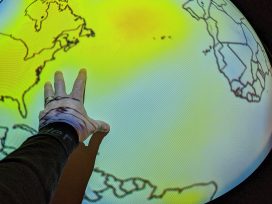
Unlike the political challenges and wars of the past, the climate and environmental crisis we now face is universal. Yet green movements remain on the political periphery and continue to be viewed in narrow, reductionist terms. What kind of solidarity can unite the emerging ecological class?

The chronicler of the life and ideas of Lucien Goldmann recalls what drew him to the writings of the Romanian-French Marxist at the tail-end of the countercultural revolution; how he gradually reconstructed Goldmann’s intellectual biography throughout the next two decades; and how after 1989 he was able to piece together the missing parts of his subject’s early life.
